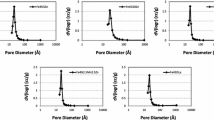Abstract
Slurry phase Fischer-Tropsch synthesis was conducted with an ultrafine iron oxide catalyst promoted with either 0.5 at% K or 1.0 at% Zr or both. Pretreatment in CO yielded higher conversions and a more stable catalyst than activation in hydrogen or synthesis gas. Hydrogen pretreatment of K promoted catalysts and synthesis gas activation in general were less effective. Mössbauer spectroscopy and XRD showedχ-Fe5C2 and ε′-Fe2.2C were formed during pretreatment in CO and did not depend on promoters present. Catalysts pretreated in H2 were reduced to metallic Fe and Fe3O4; promotion with K and Zr decreased the extent of reduction. Hydrogen pretreated catalysts, promoted with K, lost surface area and carbided rapidly under synthesis conditions. Activation in synthesis gas reduced all catalysts to Fe3O4. Subsequent synthesis did not affect the phase present for the unpromoted and Zr promoted catalysts while those promoted with K formed χ-Fe5C2 and ε′-Fe2.2C. It is concluded that pretreatment type is more important to the catalyst activity during the early period of synthesis than the impact of promotion with K and/or Zr and that changes in the bulk composition of iron catalysts do not necessarily correlate with changes in activity.
Similar content being viewed by others
References
M.E. Dry, in:Catalysis- Science and Technology, Vol. 1, eds. J.R. Anderson and M. Boudart (Springer, Berlin, 1981) ch. 4.
R.B. Anderson, in:Catalysis, Vol. 4, ed. P.H. Emmett (Rheinhold, New York, 1956) pp. 29–255.
D.B. Bukur, D. Mukesh and S.A. Patel, Ind. Eng. Chem. Res. 29 (1990) 194.
F.J. Berry and M.R. Smith, J. Chem. Soc. Faraday Trans. 85 (1989) 467.
M.E. Dry and G.J. Oosthuizen, J. Catal. 11 (1968) 18.
D.B. Bukur, X. Lang, D. Mukesh, W.H. Zimmerman, M.P. Rosynek and C. Li, Ind. Eng. Chem. Res. 29 (1990) 1588.
J.A. Amelse, J.B. Butt and L.H. Schwartz, J. Phys. Chem. 82 (1978) 558.
D.B. Bukur, X. Lang, J.A. Rossin, W.H. Zimmerman, M.P. Rosynek, E.B. Yeh and C. Li, Ind. Eng. Chem. Res. 28 (1989) 1130.
M.F. Zarochak and M.A. McDonald,Proc. Indirect Liquefaction Contractors' Meeting, Pittsburgh 1986, p. 58.
H. Abrevaya and P. Shah,Proc. Indirect Liquefaction Contractors' Meeting, Pittsburgh 1990, p. 203.
J.T. McCartney, L.J.E. Hofer, B. Seligman, J.A. Lecky, W.C. Peebles and R.B. Anderson, J. Phys. Chem. 57 (1953) 730.
G. Le Caer, J.M. Dubois, M. Pijolat, V. Perrichon and P. Bussière, J. Phys. Chem. 86 (1982) 4799.
H.C. Eckstrom and W.A. Adcock, J. Am. Chem. Soc. 72 (1950) 1042.
R.B. Anderson,The Fischer-Tropsch Synthesis (Academic Press, Orlando, 1984).
H. Itoh, H. Hosaka, T. Ono and E. Kikuchi, Appl. Catal. 40 (1988) 53.
H. Itoh and E. Kikuchi, Appl. Catal. 67 (1990) 1.
H. Itoh, S. Nagano and E. Kikuchi, Appl. Catal. 67 (1991) 215.
H. Itoh, S. Nagano, T. Urata and E. Kikuchi, Appl. Catal. 77 (1991) 37.
C.-S. Huang, L. Xu and B.H. Davis, Fuel Sci. Technol. Int. 11 (1993) 639.
C.-S. Huang, B. Ganguly, G.P. Huffman, F.E. Huggins and B.H. Davis, Fuel Sci. Technol. Int. 11 (1993) 1289.
L.-M. Tau, H.A. Dabbagh, T.P. Wilson and B.H. Davis, Appl. Catal. 56 (1989) 95.
H.H. Storch, N. Golumbic and R.B. Anderson,The Fischer-Tropsch and Related Synthesis (Wiley, New York, 1951).
P. Ganesan and B.H. Davis, Ind. Eng. Chem. Prod. Res. Dev. 18 (1979) 191.
W.S. Brey and B.H. Davis, J. Catal. 25 (1972) 81.
H. Topsøe and M. Boudart, J. Catal. 31 (1973) 346.
E.S. Lox, G.B. Marin, E. De Grave and P. Bussière, Appl. Catal. 40 (1988) 197.
M.E. Dry, T. Shingle, L.J. Boshoff and G.J. Oosthuizen, J. Catal. 15 (1969) 190.
H. Bernas, I.A. Campbell and R. Fruchart, J. Phys. Chem. Solids 28 (1967) 17.
F. Fischer and H. Tropsch, Brenstoff Chem. 7 (1926) 97.
J.P. Reymond, P. Mériaudeau and S.J. Teichner, J. Catal. 75 (1982) 39.
P. Biloen, J.N. Helle and W.M.H. Sachtler, J. Catal. 58 (1979) 95.
H.-B. Zhang and G.L. Schrader, J. Catal. 95 (1985) 325.
Author information
Authors and Affiliations
Rights and permissions
About this article
Cite this article
O'Brien, R.J., Xu, L., Milburn, D.R. et al. Fischer-Tropsch synthesis: Impact of potassium and zirconium promoters on the activity and structure of an ultrafine iron oxide catalyst. Top Catal 2, 1–15 (1995). https://doi.org/10.1007/BF01491951
Issue Date:
DOI: https://doi.org/10.1007/BF01491951




